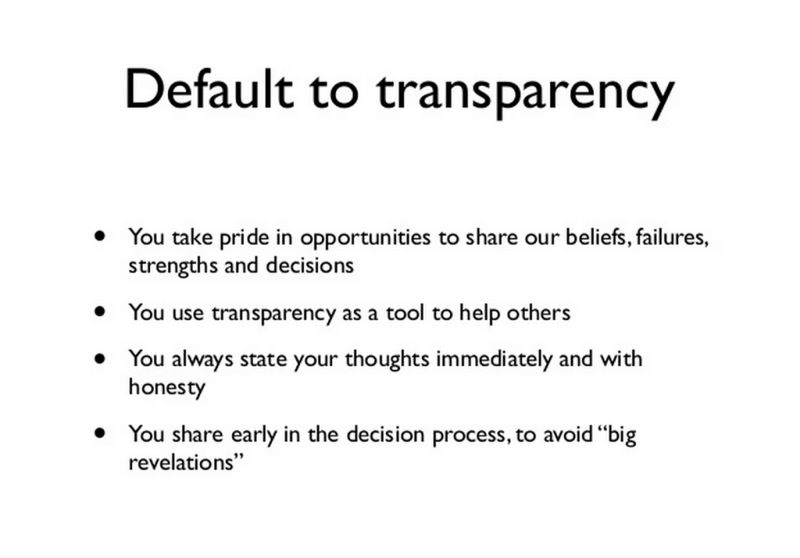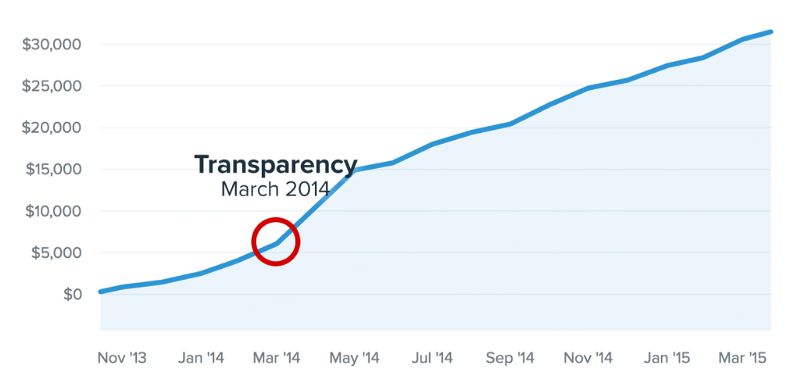Buffer: What it’s really like being radically transparent
No company quite embraces radical transparency like Buffer. Employee salaries, diversity workforce numbers, and overall revenue are just a few of the metrics that are available to the public. Even the code used to power Buffer is open source and available on GitHub!
We are discussing transparency this week, so we thought it would be great to talk with Buffer’s Director of People, Courtney Seiter, to learn about the long-term impact of radical transparency on the company. She also talks about the creation of Buffer’s Transparency Dashboard, and gives some great tips for companies interested in adopting transparency.

I was a Buffer customer way back in the day, maybe like six years ago, and it really served a purpose for me. I was sort of a late night RSS feed reader, and nobody wants to read all your content at midnight, so Buffer was the solution for me to be able to share things at the right time to engage with an audience.
And then, the more I learned about Buffer, I gradually started to gravitate from just the product to learning more about the culture. And when I saw the culture slide deck of Buffer’s ten values, I really was just blown away. It’s kind of the dream that you never imagine could be real — that you could work for a company that thinks and cares about these things and continuously works on them. So yeah, I was kind of a fangirl early on.
Diverse, I would say? I’ve done a lot of different things at Buffer. I started out in a marketing capacity, and then as we started to grow, I moved into a diversity and inclusion focused role, and that morphed into a people operations role. And all along the way, I was pretty amazed and delighted to see that the values that are written down are not just words on paper; they really are something that we talk about and think about and try to evolve and iterate on. They are something that is always on the minds of pretty much everybody that works at Buffer, and that makes it a pretty special place to work for me.
Oh my gosh, so many impacts. I’ll start internally.
One huge benefit is that the team has full context of everything that’s going on at any time. As long as we all share information, what’s going on in our email, what’s going on in our projects, or what’s going on in Slack, that gives everyone full context to make connections we might otherwise have missed to put together ideas that may have not happened otherwise, and to have the full trust in the team because they understand the full context of what’s going on.
Externally, there are also a lot of great benefits. For one, we learn. We learn so much faster than if we were to keep things to ourselves, so if we iterate on our salary formula and we put that out there to the world, tons of smart people in our audience are going to come to us and say, “How did you do this? Did you think about this? I see a potential future challenge here.” We’re able to gather all that information that’s sort of “wisdom of the crowd” information that otherwise would have been entirely lost to us. Entirely missing.
We also feel like we do what we can to promote the startup environment and community. It’s almost like open source code. We add to the world of knowledge around how startups do things, how we build, how we pay people, how we provide benefits, how we travel, and how we work as a remote team. All that stuff, we hope, can help another company, help another person launch their idea and get something off the ground, and have them do a little bit less research than maybe we had to do. It’s sort of a net benefit for the world, we hope.

That’s a good question. Most folks automatically think it’s going to be something like jealousy around knowing what another co-worker makes. Really, the only challenge we have found with transparency is that it takes time to do it. You really have to set aside time and keep making it a priority and keep making it something that you communicate.
It’s real easy to have a meeting and take the outcomes and the action items and execute on them. It’s one extra step to say, “Let me write up these notes and share them with the whole team so everyone’s aware of what’s going on.” Or, “Let me post a recording of this call somewhere where everyone can see it.” It’s something we have to recommit to often and it’s something that can easily slip by when you get really busy, but it’s something that we have seen enough gains and benefits from that we always take that extra time and energy to do it because it’s that important to us.
You know, we haven’t really seen that. Generally our investors, like folks who have chosen to be part of this journey with us, did so with eyes open knowing what we do and how we do it, and most of them feel pretty comfortable and aligned with our mission — this is the kind of company that we have set out to be.
Now often sometimes we will see someone look at the information on the dashboard, particularly around revenues and take to their own blog and say, “I see Buffer’s MRR dipping and this is what I would do about it,” and we love that. We read those with such interest and often we’ll reach out to those people. It’s that “wisdom of the crowd” thing again coming back; sharing that information just means more minds on the job.
We created the dashboard in partnership with Baremetrics. They are a like-minded company, wanted to do something fun and we were already keeping these records internally anyway. I think we just asked ourselves “Could it work? Could it work to do this?” We iterated on it a little bit in terms of what information we felt comfortable showing — not from our perspective, but from a customer’s perspective. We have signed up for transparency; but our customers — many have followed along with what we’re doing and feel really aligned with it , and many just want to have a service to Buffer their social media posts. We always want to be respectful of their privacy even as we do these crazy things with our own sort of transparency efforts. That was the only sticking point there: making sure that we were sharing as much as we could while protecting our individual customer’s privacy. Once we did that, we were able to launch it and I think Baremetrics has done that with a couple of other companies as well.

That’s definitely a situation that we had never encountered before and I sincerely hope we never encounter again. The tough thing about transparency is figuring out where the line is between what to share because you can and what to share because you should.
A lot of times, there’s a debate on if we should share something that will really freak out the team if there’s nothing they can do about it. Is that within our value of transparency? Or do we try and act on it as best we can and then share with them the outcome of what happened? That’s what we ended up choosing in this case — the latter option. We didn’t share the entire evolving situation because there’s not a lot we can do to get the information if our runway is very, very short and things are in sort of a panic state. It’s not going to do everyone a lot of good to hear that and not be able to act on it.
What we ended up doing was sharing, in retrospect, that the runway was short, and this is what we did about it. “It was a terrible, terrible day. A terrible moment. We don’t want it to ever happen again. Here are the things we’re doing to make sure it doesn’t happen again.” So that’s a judgement call, right? Maybe our team would have wanted to know every step of the way. Maybe they would have wanted to be involved. Maybe they would have had great ideas that we didn’t get to hear and didn’t get to act on because we chose to shield that information from them and only share it when it was a done deal. It’s an evolving conversation. It’s something we are always talking about. It’s something that we want to own up to when we don’t feel like we have done it the best that we could and we want to keep learning from those situations.
It’s kind of hard to say what the takeaways are. In terms of sharing bad news with the team, I think the team has expressed with us that they want to be all-in. Like, Buffer is known for this: its transparency. Everyone knows everything, that’s what they sign up for, they can handle it. So in future bad news situations, which I sure hope are few and far between, we will probably try and give everyone information much closer to the time that it happens rather than wait.
I think we get a lot more people interested in Buffer because of transparency. One benefit of transparency that I didn’t mention, and that we didn’t set out to achieve, was that of marketing success. We never said “if we share salaries, all these publications are going to be knocking on our door.” It was a natural side effect of it; people were just interested in them. As a result of that, more folks heard about Buffer and heard about Buffer’s culture than maybe they would have otherwise. When we made salaries transparent, for the next open job role, we had double the number of applicants for it. I think that’s a pretty strong sign that folks feel aligned with what we’re up to.
I think so. It kind of lets you know what you’re in for. If you’re a person who is very private and this idea is frightening and terrible to you, Buffer is probably going to be a mismatch. If you’re someone who’s open to that idea, and you don’t have to be entirely gung-ho, but open to learning more and learning about the philosophy behind it and why we see the benefit of it, then Buffer could be a great spot for you.
I would say small steps are fine, you know? It would be tough to go from a very traditional organization that holds things quite close to the vest and then just one day open up everything. You can take steps in between. If you want to be more open about salaries, you don’t have to share them with the world. You don’t have to post them to the Internet with people’s names and cities. You can share bands of salaries internally, and if that goes okay and people aren’t freaking out, maybe you can share actual salaries internally. If that goes really well you can think about the next step, but break it up into smaller pieces. Radical transparency is not something that happens overnight. It’s the result of many, many small decisions over many, many years.
*Many companies are adopting levels of radical transparency, including us here at Fog Creek. *

